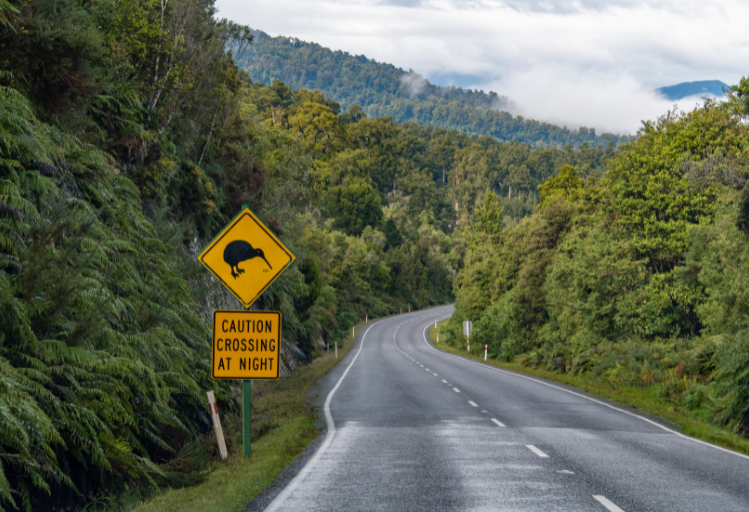
New research from AA Insurance1 reveals more than a quarter of Kiwi drivers don’t pay attention to wildlife road signs2 – increasing their chances of a dangerous, distressing and potentially costly collision.
In 2024, AA Insurance saw an 11% year-on-year increase in motor vehicle claims involving collisions with an animal3, totalling more than $2.45 million in customer claims4.
AA Insurance Motor Assessing Manager, Weaver Vagana, says, “We take pride in our unique and native wildlife in Aotearoa, yet the data suggests too many drivers are overlooking the important reasons wildlife road signs are there.
“Collisions with animals can happen in a split second – often resulting in swerving or abrupt braking, which can significantly increase the risk of serious accidents, as well as being an emotionally distressing and disruptive experience for the driver.
“These collisions can also cause a lot more damage than you would expect. In fact, one in 10 animal collision motor claims in 2024 were deemed a total loss.”
According to AA Insurance’s claims data, most animal collisions in 2024 occurred in rural areas around Canterbury, Waikato and Auckland.
Customers who were unlucky enough to experience an animal collision often report how quickly the animal appeared on the road in front of them, especially at night when visibility is lower.
Weaver adds, “Drivers can help reduce the risk of animal and wildlife collisions by taking note of the warning signs, using their high beams at night when there is no oncoming traffic, sticking to the speed limit, and ensuring their headlights are working properly.
“If an animal crosses your path while driving, it is important not to swerve to avoid the animal if it risks your own safety. If a collision does occur, ensuring you and your passengers are safe must be your first priority,” he said.
AA Insurance’s tips for drivers to avoid a collision with wildlife and other animals:
Check your speed and take extra care to scan the road and shoulders for wildlife and other animals that may be wandering the road or about to cross.
Use high beams in dimly lit areas at night, like rural roads, if there’s no oncoming traffic.
Be extra cautious at dawn and dusk when wildlife tends to be more active.
If a collision is unavoidable, do not swerve at the risk of your own safety – swerving could cause a more serious crash or result in losing control of the car.
If you encounter a collision with wildlife while driving, the first thing to do is pull over where it is safe to do so and turn on your hazard lights. Try and help the animal and assess its condition if you can do so safely and in a humane way. If the animal is injured or distressed contact a local vet, animal rescue or the SPCA to seek help. Injured animals can be unpredictable, so avoid direct contact if they seem distressed or aggressive.
If the animal presents a road safety risk or is an obstruction, call *555 to report a road incident.
Once you are able to do so, inspect your vehicle for damage especially anywhere the animal may have collided with your vehicle such as the bonnet, headlights, windscreen, wheels and tyres. If you can, take a photo of the damage to your vehicle to provide to your insurer.
If something doesn’t seem right with your vehicle, get it checked out by a qualified professional as soon as possible – and if it doesn’t feel right to drive, don’t risk it.
Regions where animal collisions are most likely to occur, based on AA Insurance motor claims data:
Canterbury
Waikato
Auckland
Otago
Bay of Plenty
Manawatū-Whanganui
Northland
Southland
Hawke's Bay
Wellington
1 AA Insurance research conducted by Kantar. A nationally representative sample of over 972 New Zealand drivers (aged 18+) completed an online survey in October 2024 (margin of error 3.1%)
2 The survey asked, “Do you pay attention to wildlife signs? Which of the following best describes your driving behaviour around wildlife signs?”. 17% responded “I do notice them but drive on without reducing my speed” and 11% responded “I don’t notice them”.
3 AA Insurance motor claims data from 1 January 2023 to 1 January 2024.
4 All AA Insurance animal collision settled motor claims paid out in 2024.
About AA Insurance
AA Insurance is a New Zealand-based joint venture between Vero Insurance New Zealand Limited and the New Zealand Automobile Association Limited ('NZAA'). Vero is owned by Suncorp Group Limited, a listed Australian company. NZAA is an incorporated society that is governed by a National Council and Board. Since 1994 we have provided home, contents and car insurance in New Zealand and in 2018 we introduced small business insurance.
We underwrite our own policies and sell direct to New Zealanders. Our New Zealand-based teams looks after 560,000+ customers with more than 1,100,000 policies. Standard and Poor's (Australia) Pty Ltd has given us an Insurer Financial Strength Rating of AA- (Very Strong).
We are consistently recognised in industry awards and honours. This includes being voted the Reader's Digest Most Trusted General Insurer for 14 years running, named Canstar's 2023-2024 Outstanding Value Award winner for Home and Contents insurance and ranked 6th among 50 of New Zealand's top consumer-facing corporates in the Kantar Corporate Reputation Index in 2024.
Find out more at www.aainsurance.co.nz
For more information please contact:
AA Insurance Media Team
mediacontact@aainsurance.co.nz



